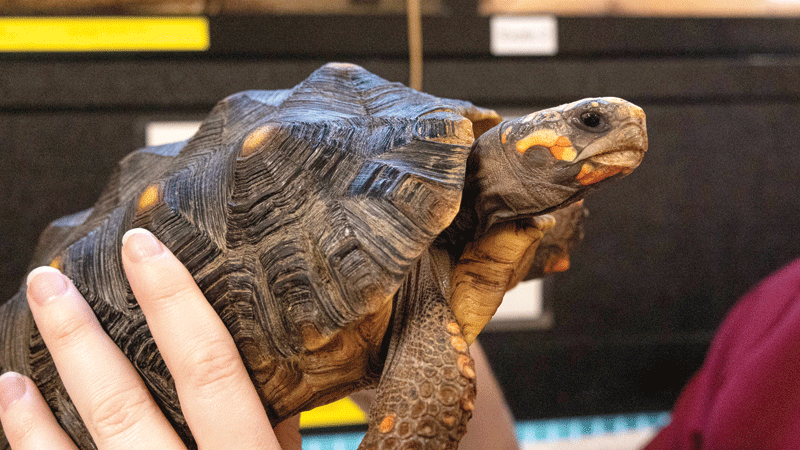
In the dynamic landscape of veterinary medicine, integrating technology with traditional care methods continues to redefine the boundaries of what is possible. Historically, the focus of custom-fit prosthetics has predominantly catered to more common pets, such as dogs and cats. However, the story of Cookie, a 10-year-old male red-footed tortoise, showcases the necessity for specialized solutions for a broader range of species, illustrating a vital shift in animal welfare.
Red-footed tortoises are inherently curious creatures, a trait that occasionally leads to precarious situations. During a particularly unlucky exploration, Cookie found himself flipped onto his back and pinned under a log, unable to right himself. This unfortunate incident resulted in lameness affecting his left front limb. Cookie was soon under the care of the exotics care team at DoveLewis Veterinary Emergency & Specialty Hospital in Portland, Ore.
Presentation
During Cookie’s examination, necrosis caused by vascular injury that occurred when he was pinned in his enclosure was found to be the cause for his left front limb lameness. Due to the extensiveness of the ischemic damage to the left front limb, it could not be salvaged and would require amputation.
The veterinary team informed Cookie’s owners front limb amputations had been performed successfully on turtles and tortoises and generally result in a good quality of life post-surgery. To improve mobility, chelonian amputees typically require prosthetics on their plastron to help the shell slide on the floor when ambulating with the remaining three limbs. Cookie’s owners did not hesitate to agree to the procedure.
This commitment from Cookie’s owners is indicative of a broader trend among pet owners who are increasingly willing to invest in their pets’ health, seeking advanced care options that promise an enhanced quality of life.1 This shift has spurred the demand for innovative, custom-tailored solutions that are adapted not only to the species, but to the individual animal’s unique needs.
The veterinary prosthetics and orthoses industry has seen technological advancements that have not only driven the growth of the sector, but also expanded the scope of whom it can serve. Innovations, such as 3D printing, along with improved designs reducing discomfort, and the use of materials specifically tailored for animals, have significantly enhanced the effectiveness of these devices.2
Treatment plan
Recognizing the limited availability of “off-the-shelf” prosthetic solutions suitable for exotic species, such as Cookie, the DoveLewis veterinary team embarked on an innovative project. Initial discussions explored rudimentary solutions for chelonian amputees, such as halved pool balls or furniture sliders. However, these were quickly deemed inadequate for addressing the specific anatomical and environmental challenges faced by Cookie. The necessity in the prosthetic market underscores the need for custom-fit prosthetics catering to the diverse requirements of the animal, regardless of species.
The solution for Cookie materialized through advanced technology—3D printing. Knowing fellow colleague, Sarah Tauber, DVM, owned a 3D printer for personal use, the DoveLewis Exotics Care team recognized the potential to use Dr. Tauber’s printer in creating a custom-fit prosthetic for Cookie. The solution needed to not only be size-appropriate, but also capable of mobility in the variety of terrains tortoises are known to explore.
The design process was intricate, requiring a deep understanding of Cookie’s anatomy and the biomechanics of tortoise movement. The objective was to enable Cookie to ambulate effortlessly on different indoor surfaces, such as hardwood and carpet, as well as on grass, mulch, and dirt in his outdoor enclosure. Given red-footed tortoises can be quite messy, it was crucial the prosthetic be easy to clean for
his owners.
The result was a 3D-printed prosthetic: a bracket system that could be securely affixed to Cookie’s shell. This system features interchangeable attachments designed for various terrains, providing Cookie with not just mobility, but the ability to interact with his environment in a manner akin to his natural behavior.
The flexibility of interchangeable attachments not only facilitated Cookie’s comfort and adaptability, but also simplified the maintenance and cleaning of all the pieces (Figure 1).
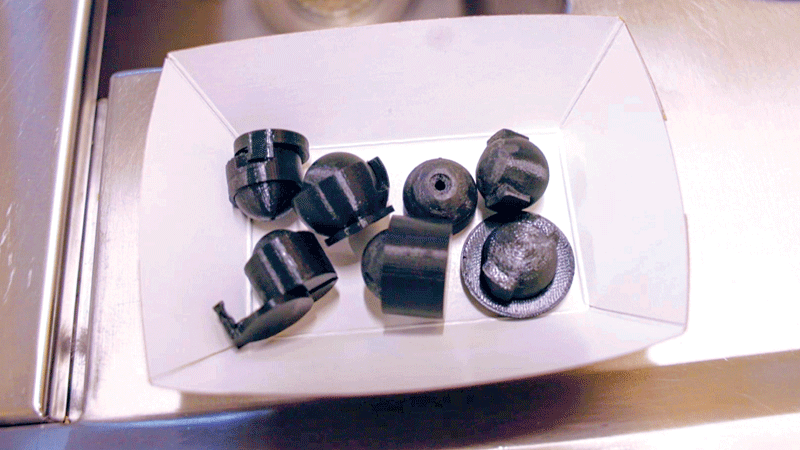
Surgery
The day of the surgery was a critical moment. Cookie was placed under anesthesia to amputate his left forelimb. The surgical procedure chosen was a mid-humeral amputation to ensure the distal end of the limb was shortened enough to be tucked into the shell, preventing damage to the remaining stump.
Allis tissue forceps were used to retract the distal end of the limb to help expose the surgery site outside the shell. Once the soft tissue was removed, the bone of the humerus was transected using a narrow one-inch sterile hobby saw. The narrowness of the saw allowed for good access into the shell and a sharp cut along the bone.
Viable soft tissue was left intact during the surgical approach and was used in closing to cushion the end of the remaining humerus. The scales were closed in an inverting pattern to achieve apposition of the skin assisting in healing.
Once the amputation was completed, the plastron’s surface was lightly scored using a Dremel to allow the prosthetic’s bracket to be attached with surgical bone cement. Cookie was then recovered from the anesthesia (Figure 2).
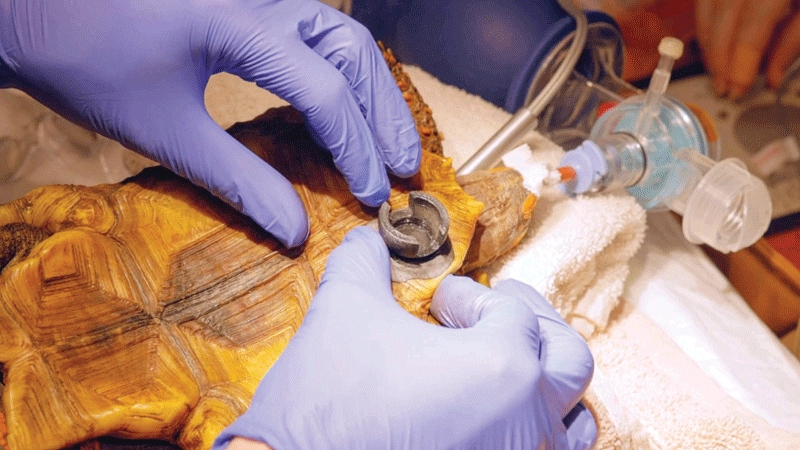
Today, Cookie navigates both his home and outdoor environments with ease, and his quality of life has significantly improved since the incident. The feedback from Cookie’s owners regarding the performance of the prosthetic in various settings has been positive, reinforcing the success of integrating sophisticated technology into veterinary care.
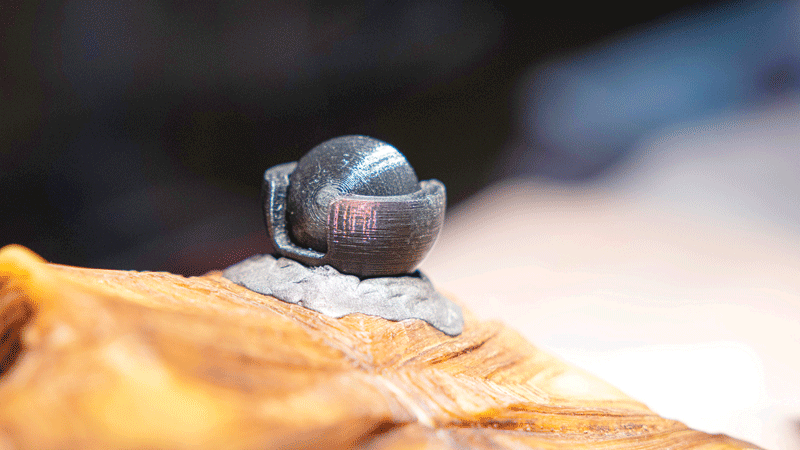
Success story
Cookie’s story is a testament to the resilience inherent in animals and the capabilities of modern veterinary medicine. The advancements in custom prosthetics for exotic animals highlight a growing trend in veterinary practice, as both veterinarians and pet owners recognize the profound benefits that tailored prosthetic solutions bring—not only enhancing the well-being of the animals, but also simplifying care routines for the owners.
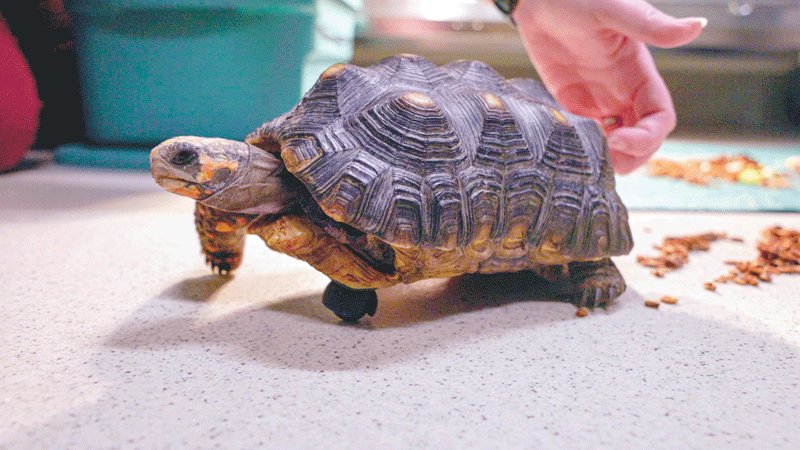
As veterinarians continue to encounter a diverse array of species, the demand for such personalized treatments will likely increase, heralding a new era of veterinary care where every animal, no matter how exotic, receives the tailored treatment they need to thrive.
Kelly Flaminio, DVM, serves as the senior exotics veterinarian and veterinarian lead at DoveLewis Veterinary Emergency & Specialty Hospital in Portland, Ore. Dr. Flaminio embarked on her 15-year veterinary career with an emergency and critical care internship at DoveLewis in 2009. Afterward, she gained extensive experience in exotic animal care through a second internship at the Wildlife Center of Virginia, and later as a staff veterinarian at both the Oregon Zoo and Bird Alliance of Oregon. Returning to DoveLewis in 2021, Flaminio spearheaded the launch of their dedicated exotics care service. Flaminio can be contacted at contact@dovelewis.org.
References
- Thiel, Kristin. “We Love Our Pets, and Our Spending Proves It.” U.S. Bureau of Labor Statistics. November 6, 2023. https://www.bls.gov/opub/btn/volume-12/we-love-our-pets-and-our-spending-proves-it-1.htm
- Orthotic Device Use in Canine Patients: Owner Perception of Quality of Life for Owners and Patients by Sera Lee, Theresa M. Wendland, et al. Frontiers in Veterinary Science. Published November 2021. https://www.ncbi.nlm.nih.gov/pmc/articles/PMC8600258
